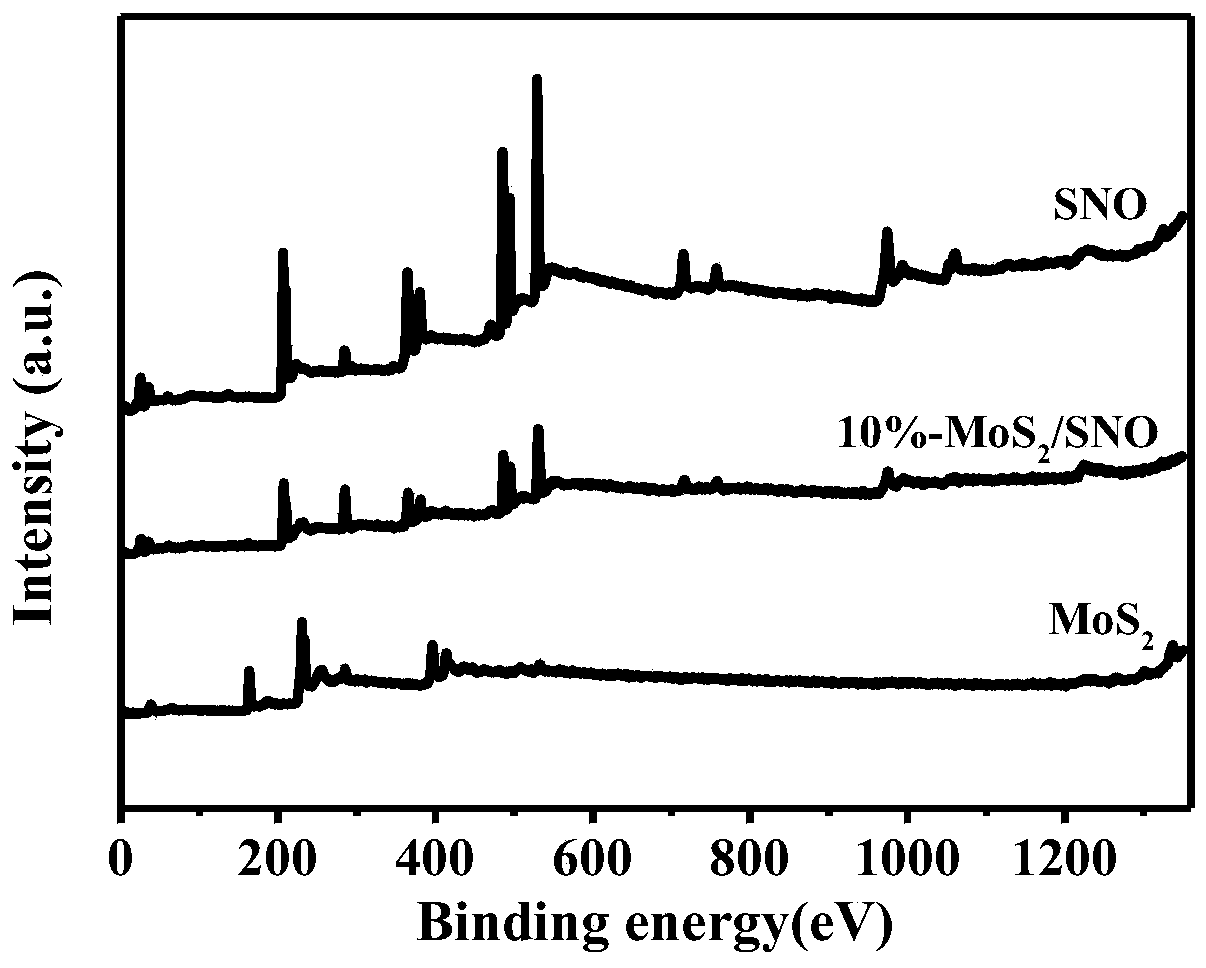A kind of molybdenum disulfide/tin niobate composite nanomaterial and its application
A technology of composite nanomaterials and molybdenum disulfide, which is applied in the fields of composite materials and clean energy to achieve the effects of improving stability, high yield and low production cost
- Summary
- Abstract
- Description
- Claims
- Application Information
AI Technical Summary
Problems solved by technology
Method used
Image
Examples
Embodiment 1
[0031] Example 1SnNb 2 o 6 Preparation of nanosheets
[0032] SnNb 2 o 6The preparation adopts the method of hydrothermal reaction: Weigh 0.5g of niobium pentoxide and 2.2443g of potassium hydroxide in a 50mL reactor lined with polytetrafluoroethylene, add 35mL of deionized water to it, and put the reactor Put it in an oven and react with water at 180°C for 48 hours. After naturally cooling to room temperature, a clear precursor solution is obtained. Transfer the solution to a 50mL beaker, adjust the pH of the solution to 8 with a concentration of 2mol / L dilute hydrochloric acid, and then add 0.4245g Tin protochloride dihydrate, adjust the pH of the solution to 2 with dilute hydrochloric acid at a concentration of 2mol / L again, transfer the solution to a 100mL reactor lined with polytetrafluoroethylene, put it in an oven, and conduct a hydrothermal reaction at 200°C for 48h. Cool to room temperature, centrifuge to obtain yellow particles, wash with water and alcohol three ...
Embodiment 2
[0033] Example 2MoS 2 Preparation of nanosheets
[0034] MoS 2 The preparation adopts the method of hydrothermal reaction: Weigh 0.242g sodium molybdate dihydrate and 0.38g thiourea to dissolve in 60ml deionized water, stir magnetically for 30min to form a clear solution, transfer the solution to 100mL lined with polytetrafluoroethylene Put it in a reaction kettle of vinyl fluoride, put it in an oven, conduct a hydrothermal reaction at 210°C for 24 hours, cool to room temperature, centrifuge to obtain black particles, wash with water and alcohol three times, centrifuge, and dry in an oven at 60°C for 12 hours.
Embodiment 3
[0035] Example 3 5%-MoS 2 / SnNb 2 o 6 Preparation of composite materials
[0036] MoS 2 / SnNb 2 o 6 The preparation of the composite material adopts the hydrothermal method: weigh 80mg SnNb 2 o 6 Dissolve in 60ml deionized water, stir magnetically for 15min, and then ultrasonicate for 60min in an ultrasonic machine with a power of 250W to obtain a uniform yellow solution. Weigh 6.35mg sodium molybdate dihydrate and 10mg thiourea, dissolve them in the above solution, and stir magnetically for 30min , transfer the solution to a 100mL reaction kettle lined with polytetrafluoroethylene, put it in an oven, and conduct a hydrothermal reaction at 210°C for 24 hours. ℃ drying for 12h to obtain the 5%-MoS 2 / SnNb 2 o 6 composite material.
PUM
 Login to View More
Login to View More Abstract
Description
Claims
Application Information
 Login to View More
Login to View More - R&D
- Intellectual Property
- Life Sciences
- Materials
- Tech Scout
- Unparalleled Data Quality
- Higher Quality Content
- 60% Fewer Hallucinations
Browse by: Latest US Patents, China's latest patents, Technical Efficacy Thesaurus, Application Domain, Technology Topic, Popular Technical Reports.
© 2025 PatSnap. All rights reserved.Legal|Privacy policy|Modern Slavery Act Transparency Statement|Sitemap|About US| Contact US: help@patsnap.com



